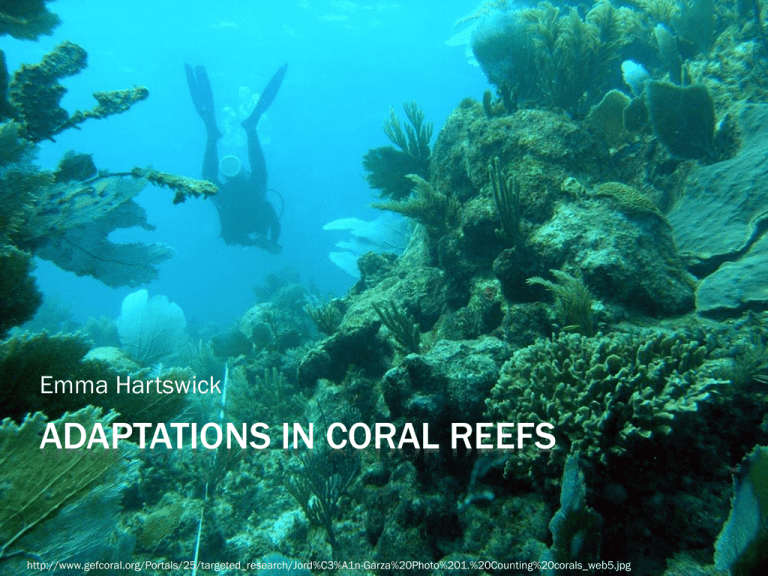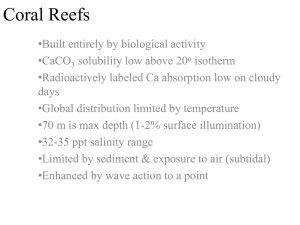
Emma Hartswick
ADAPTATIONS IN CORAL REEFS
http://www.gefcoral.org/Portals/25/targeted_research/Jord%C3%A1n-Garza%20Photo%201.%20Counting%20corals_web5.jpg
WHAT ARE CORAL REEFS?
Coral reefs form because of
polyps, which are soft bodied
organisms related to anemone
and jellyfish
• At their base is a hard
limestone skeleton known as a
calicle
• Reefs form when a polyp
attaches to a rock and divides
into thousands of clones
• What we recognize as coral is
the connected calicles of polyps
functioning as a single
organism
•
WHERE ARE THEY FOUND?
• Coral gets its varied colors by hosting species of algae called
zooanthellae
• These algae require adequate sunlight for photosynthesis, so
coral reefs are found in warm, shallow waters in tropical
climates throughout the world
• The algae transfers needed nutrients to the coral, although at
night some corals may ensnare zooplankton or small fish for
food
ECOLOGY OF A REEF
• Coral Reefs are like rainforests of coral
• They contain many layers, each of a differing type of coral
structure
• Coral reefs are only 0.2 % of the world’s oceans but contain
25% of marine life
• Because of the close proximity of so many species competing
for limited resources, organisms have evolved into very
specialized niches which build the complex interdependent
hierarchy of the reefs
• Adaptations are key to survival in a reef, separating organisms
from each other and creating the diversity that is both
distinctive to reefs, and necessary to success in them
TYPES OF ADAPTATIONS
There are many types of adaptations that aid organisms
in survival, but those most common in reefs are
• Symbiotic
• Defensive
• Predatory
• Reproductive
SYMBIOSIS
• Symbiosis is a relationship between two species in which
one or both of the species benefits
• Symbiotic relationships evolve when species living close to
one another become dependent on each other’s functions
• Overtime, these relationships are refined, further drawing
the pair together
• In coral reefs, the most common form of symbiosis is
mutualism, in which both species benefit from the
relationship
• Example: Anemonefish and anemone
• Example: Giant clams and algae
CLOWN ANEMONEFISH
• “Finding Nemo” fish are really one of many
clown fish look a likes
• Real anemonefish have slightly different
shape and habitat
• Approximately 4.3 inches, live 6 -10 years
• Live in Indian Ocean, Red Sea and West
Pacific
• “Dance” with anemone, touching it with
different body parts to acclimate
• Layer of mucus makes the fish immune to
the lethal sting
• Fish gains safety and food scraps, in turn,
cleans parasites off anemone, drives off
intruders and lures in prey
• Anemone immunity is acquired and can be
lost
http://imageshack.us/photo/myimages/204/findingnemoi.jpg/sr=1
ANEMONEFISH BEHAVIOR
• All anemonefish born are male, and only switch to
become the group’s dominant female (which the
largest males will mate with)
• This allows groups to be self sufficient if dominant
female dies
• Creates a functioning hierarchy that increases the
stability of the population
• One of few species that switch from male to female.
Sex changes from female to male are much more
common in reef
GIANT CLAM
• Clam can reach 1.2 m, weigh
500 lbs and live up to 100 years
• Once they clam attaches early
in its development, it cannot
move
• Clam reach this large size by
eating the sugars and proteins
produced by zooanthellae (algae)
on their tissues
• In return for the food the clam
receives, it provides a safe, sun
lit home where the algae can
photosynthesize
http://2.bp.blogspot.com/zjdokUFz2_s/TWYtIo2WbxI/AAAAAAAABGU/9ji8h1
oUfKI/s1600/1626-CLAMBIG.JPG
GIANT CLAM
• Adult clams are simultaneous hermaphrodites. Born females
and mature to into hermaphrodites
• Release both male and female gametes, but 30 minutes apart
to avoid self fertilization
• First egg release triggers releases in other clams within
minutes, beginning chain reaction of fertilization that increases
diversity
• Once established within first weeks, can no longer move –
hermaphroditic reproduction a solution to lack of variation
DEFENSIVE
• Some organisms have evolved special defensive
mechanisms including behaviors, colorations and
camouflages
• These techniques may either hide them from predators,
antagonize and defend against attackers physically, or warn
enemies to stay away
• Example: Sea cucumbers have evolved unusual ways to
frighten off assailants
• Example: Porcupinefish can inflate themselves to ward off
predators
• Example: Lionfish are brightly colored to warn enemies
and are poisonous if attacked
SEA CUCUMBERS
• Sea cucumbers are related
to sea urchins and star fish
and live at the bottom of
reefs or on the ocean floor in
the sand
• They eat algae, small
animals and wastes and
function much like
earthworms for their aquatic
environments
• Can be 0.75 inches to 6.5
feet long
SEA CUCUMBER’S DEFENSE
• When threatened, sea cucumber release sticky threads that
trap their predators
• Others can violently contract their muscles and excrete their
internal organs to confuse and frighten their enemies
• These lost vitals are quickly regenerated
http://bioweb.uwlax.edu/bio203/2011/moede
_marl/images/Cuvierian%20tubules.jpg
PORCUPINEFISH
• Shaped like a short baseball bat
approximately 3 feet long
• Live in weeds or caves/holes of reefs
and lagoons
• Scales of fish form spikes that lie flat
against the fish’s body
• When threatened, fish gulps water
and inflates body, reaching double or
triple their normal size
• Spines sick straight out, frightening
predators and making the fish
extremely difficult to eat
OTHER PORCUPINEFISH DEFENSES
• Aside from being a prickly lunch, porcupinefish have high levels
of poison in their reproductive tissues and livers
• Toxins accumulate from the types of algae that they ingest
when preying on mollusks, snails and sea urchins
• Would-be predators remember becoming sick after attacking
these fish, discouraging them from trying to eat them in the
future
• The combination of the adaptations that the porcupinefish has
means that it has very few predators…. Like 1 in adulthood
Porcupinefish also have special beak-like mouths that are well
suited to crushing the crunchy critters that they eat
LIONFISH
• Average of 1 foot in length
• Lionfish have an array of
venomous spines on their
back
• They use their poison only for
protection, not to hunt their
own prey
• Their brightly colored,
vibrantly patterned bodies
and showy pectoral fins warn
assailants to keep their
distance
PREDATORY
• Some organisms have evolved special hunting
techniques that allow them to more efficiently obtain
food in the competitive reef environment
• Example: Geographic Cone Snail is small but
venomous to make up for its sluggish movements
• Example: Carnivorous star fish has evolved into a swift
and efficient hunter
GEOGRAPHIC CONE SNAIL
• Approximately 6 inches
• Has toxic venom that paralyzes
fish instantly since creature
itself very slow
• Potent poison containing
100’s of toxins, delivered
through harpoon like tooth that
shoots out of extendable nose
• Live on reef edge under dead
coral, in sand pocket or on reef
• Feed at night and capture
small fish which they store and
eat individually
• Has caused human deaths
Isolated proteins in venom
have painkilling effects for humans
more potent and less harmful than
morphine.
Intricate shell design
prized by collectors.
“tooth” can reach any part
of shell, making it unsafe to pick up.
CROWN OF THORNS STARFISH
• Carnivorous starfish that
feeds on coral polyps
• Can grow to a diameter of 40
cm
• Starfish is extremely mobile
for such an organism and is
able to move backward and
forwards, turn around, and use
its 12-19 legs independently
from each other
• They are insensitive to touch
or gravity but sense predators
through water born chemicals
http://divegallery.com/crown-of-thorns.jpg
CROWN OF THORNS FEEDING HABITS
• To feed, they climb onto coral
and release digestive enzymes
from stomach that liquefy and
absorb its tissues
• Has a significant damaging
effect on reefs, which has
increased since 70’s
• Capture of reef fish has allowed
Acanthaster planci to proliferate
by reducing natural species
control
• Has few predators due to
poisonous spines, which cause
local paralysis and nausea
REPRODUCTIVE
• Some organisms have developed sexual
behaviors that allow them to be better suited to
the reef environment
•Reproductive adaptations allow for more certainty
of species survival and increased diversity
• Example: Coral Trout change sex part way
through life
•Example: Different species of Coral have evolved
to reproduce asexually or sexually
CORAL TROUT
• Coral trout are protogynous
hemaphrodites, meaning that
the entire species is born
female but changes to male
as the fish matures
• Sex change occurs at an
average of 42 cm in size,
approximately 7 years old
• Trigger of the sex change is
unknown, but may have
evolved from fishing pressures
• Supported by evidence that
sex ratios vary in areas open
or closed to fishing.
CORAL TROUT REPRODUCTION
• Spawning occurs when water temperature warms
• Event takes place at dusk and when there is a strong tidal flow
to minimize the risk of predators attacking the fertilized eggs
• To begin courtship, males swim down to the bottom where
females are resting and perform an elaborate mating dance
• If the female consents, the two swim rapidly to the surface and
release their gametes as they turn quickly, forming a cloud
where the eggs are fertilized
• The larvae are vulnerable at first and feed off the nutrients of
their membranes, but they quickly mature in the water column,
are dispersed to different reefs, and soon catch their own prey
ASEXUAL CORAL REPRODUCTION
Budding:
• New polyps bud off of parent polyps when parent
reaches a certain size
• Creates new polyps that are genetically identical to
the parents
Fragmentation:
• Broken part of original coral may re-establish if it
settles in a favorable location, remains identical to the
parent colony
SEXUAL CORAL REPRODUCTION
Broadcast Spawning:
• Distributes offspring over a larger area
• Coral releases both gametes which
float to surface and fuse to form
planulae
• Planula float in water column until they
find a suitable space to sink and
colonize
• Many produced to compensate for high
mortality
• Only spawn a few days of every year
• Timing is key and each species
synchronizes on same day
• Timing based on temperature, the
length of the day and the lunar cycle
• Final release occurs at sunset
http://ngm.nationalgeographic.com/2011/05/great-barrierreef/doubilet-photography
SEXUAL CORAL REPRODUCTION
Brooding
• Male gametes sink and are taken in by female coral and
fertilized
• Planula released from female at a mature stage
• Successful but occurs across much smaller distances
Both forms of sexual reproduction increase Coral
diversity and thus, the survival of the species









